Dell Precision T1600: Workstation Class
by Dustin Sklavos on May 2, 2011 4:55 PM EST- Posted in
- Systems
- IT Computing
- Dell
- Intel
- Xeon
- Precision
- Workstation
- Enterprise
- NVIDIA
Gaming Performance
Truthfully this page is largely irrelevant for a system like the Dell Precision T1600. This isn't a gaming tower; it's meant to be used for heavy duty work. But I can't be the only person who games on their work machine from time to time, and I'm at least personally curious to see what a single-slot, underclocked GF106 can actually do. Right now, the fastest video card available that doesn't require an extra power lead is PowerColor's Green Radeon HD 5750, and the fastest stock card available is the Radeon HD 6670. While I don't have results for the latter, we can at least extrapolate performance of the former from the stock-clocked Radeon HD 5750 in the Puget Serenity.
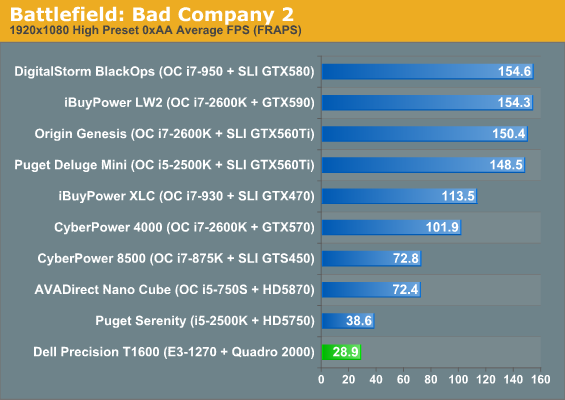
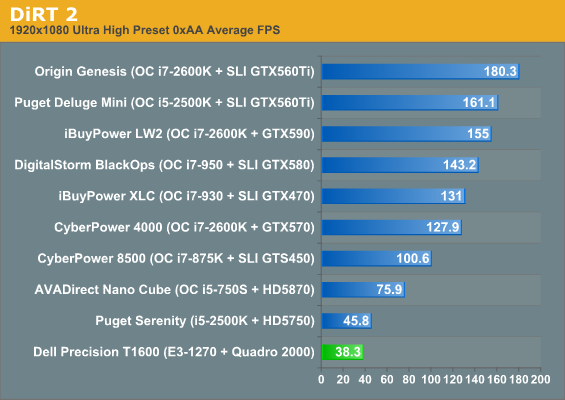

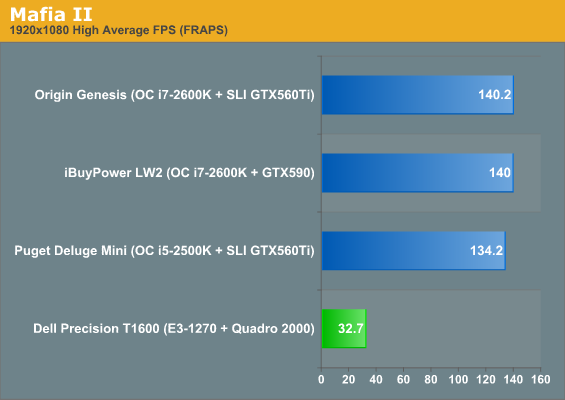
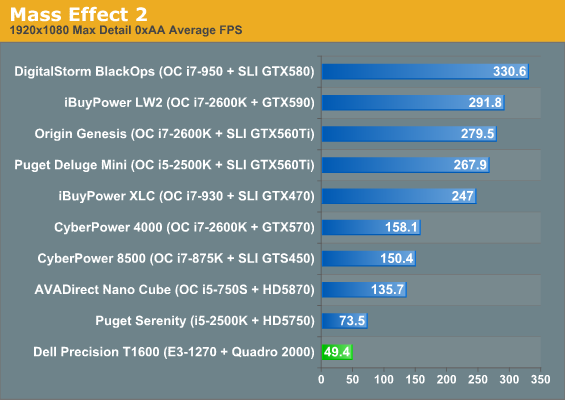
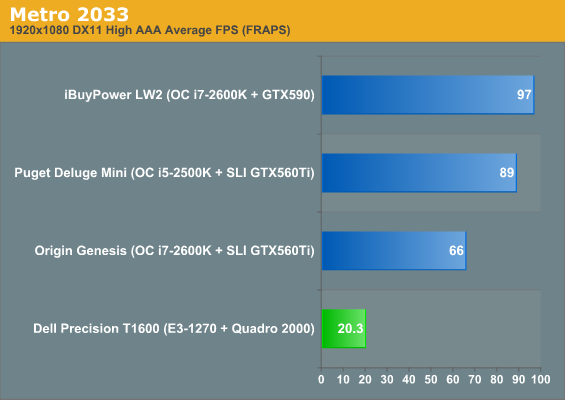
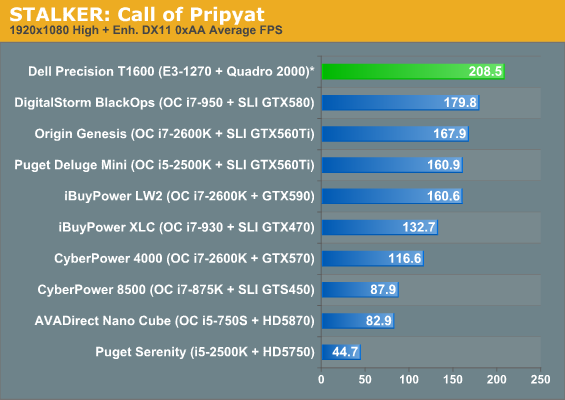
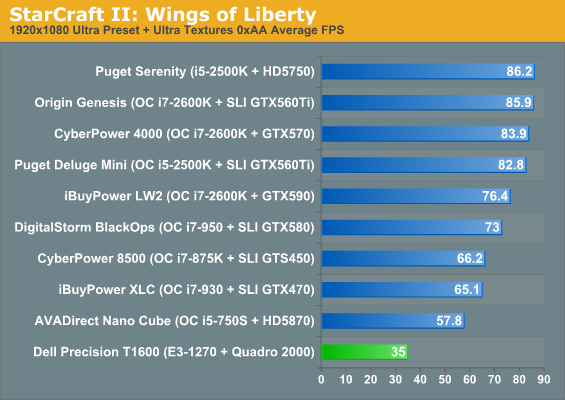
Unsurprisingly it comes in last in every test in our "high" suite except for STALKER, where it inexplicably refused to render any of the post-processing or dynamic shadows (hence the abnormally high score). We left that result there more as a cautionary tale: workstation graphics cards require workstation drivers, and there are optimizations and differences between NVIDIA's Quadro and GeForce drivers that show up on occasion. It appears STALKER is one title where the current Quadro drivers have a bug, and there are bound to be others. The same story would hold true for AMD's FireGL and Radeon lines.
As far as the actual performance, these are pretty challenging settings for anything from a Radeon HD 5770 on down, so most users would want to turn down a few settings. At least the Quadro 2000 could be used for some moderate gaming on a whim, and if you've read our laptop reviews you'll also know that the "poor" results above would rate pretty highly on a mobile system. It's all a matter of your chosen reference point.
UPDATE: The "Ultra" results were removed and the following section added to put the T1600's review more in line with its intended market.
Pricing
The Dell Precision T1600's gaming chops are questionable but that's not what it's there for; again, the exercise was more to see what a single-slot GF106-based graphics card might look like. Try to keep in mind that while the T1600 isn't a gaming machine, it's most definitely a workstation, and the results from SPECviewperf 11 on the previous page are more than double what a consumer-oriented graphics card is liable to produce.
Since an overclock is much harder to curate, workstations are almost never actually overclocked, either. These are gaming systems that have been souped up for their task, but when you put them in a workstation environment, particularly suited to CAD work, they're going to fall behind the Precision T1600. With these things in mind, let's see how pricing breaks down:
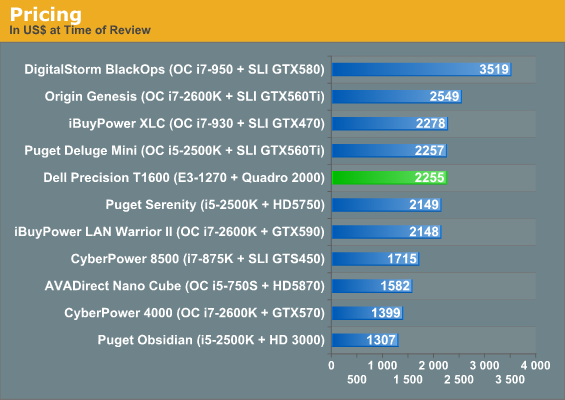
The T1600 is a bit cheaper than some of our overclocked gaming machines and well behind monsters like Origin's Genesis and DigitalStorm's BlackOps. For what you get, though, the price is actually fairly reasonable despite Dell's tendency to overcharge on upgrades.










29 Comments
View All Comments
TrackSmart - Monday, May 2, 2011 - link
I appreciate you calling Dell out on the insane pricing structure, but I think even greater outrage was warranted. If Dell wants to add $200/machine to cover the cost of software certifications and support, I'm fine with that. That would be honest pricing. HOWEVER, that's not what they do. Instead they charge $345 to upgrade to a 1GB hard disk, which costs $70 at retail. That's just plain outrageous and *deserves* outrage. Don't be afraid to call it as you clearly see it!Exelius - Tuesday, May 3, 2011 - link
Forgive me; I just took a pricing class where the mantra was "your customer is your enemy and your competitors are your friends who you cannot legally talk to." But the reason they do this is because the people who purchase this type of machine are often engineering firms. Revvit files are MASSIVE, so disk space is definitely a priority. But you have 2 types of engineering firms who buy these; large ones who order 25-50 at a time and who will likely be installing a pre-built image anyway, or small firms who are ordering less than 5 machines. The labor to build an image for 5 machines isn't worth the $1500 you'd spend upgrading the disk on those machines directly.Customers who aren't willing to pay a high price for more disk space likely aren't willing to pay much of anything for more disk space, as they're just going to install their own disks anyway. So gouge the shit out of the customers who are. The biggest lesson I learned from that class is that these feature prices are very carefully calculated, and cost is only a consideration when the optimal price you can charge is less than the cost of the feature.
mariush - Monday, May 2, 2011 - link
The page titled "Build, Noise, Heat, and Power Consumption" has almost no mention of actual power consumption.Just a fleeting mention of 142 watts but it's not clear if you just added up the 80w tdp of the cpu and the watts for the video card to get this value.
Please get a Kill-a-watt type of device and measure power in idle and when doing something cpu intensive, at least.
It would also be nice to get the idle power usage and then replace the power supply with another power supply that you know how efficient it is, to actually determine the actual power efficiency of this 260 something power supply Dell provides.
I have a suspicion that 65% is for maybe 20% load but if the system uses 140 watts when in use, the efficiency should be a bit higher.
Dustin Sklavos - Tuesday, May 3, 2011 - link
Actually, I did use a Kill-a-watt power meter. Those idle and load numbers are exactly how things worked out.7Enigma - Tuesday, May 3, 2011 - link
I'm sorry Dustin, what idle power numbers? I can only see the 142w which I'm assuming is load you measured but don't see any idle numbers. I would also second the request for a quick replacement using an 80+ efficiency PSU and retesting idle/load values.Honestly the combination of POS PSU and RAID 0 with no backup for a workstation is downright laughable IMO.
Dustin Sklavos - Tuesday, May 3, 2011 - link
You're absolutely right. The graphs were in the system, just didn't get posted. I've added them.7Enigma - Tuesday, May 3, 2011 - link
Dell are you kidding me? Of all the places where RAID 0 has it's place a workstation is about the worst place I could possibly think of.meorah - Tuesday, May 3, 2011 - link
I appreciate the effort that this site is taking to broaden its horizons beyond just gaming/enthusiast systems and appealing more to the IT side of computing.That being said, this review contains many pointless graphs that should have been edited out, and just because Dustin was curious about how well this workstation runs CoD and SC doesn't mean you should let him run useless tests. It would have been much more beneficial to have him run the workstation benchmarks on all the boutique builds so he would have a reasonable baseline chart to compare how much better the nvidia 2000 can handle its intended applications than a high-end gaming system.
And yes Dell charges too much for memory and drives... I don't believe I've ever built a single virtual server host with factory upgraded RAM/HDD. Just base config them and save about $2k per host by buying your own memory and drives.
ochentay4 - Tuesday, May 3, 2011 - link
im my opinion, the only important benchmarks when testing a workstation are cinebench 11.5 and specviewperf. maybe use pcmark and 3dmark and cinebench 10. why test games?the most important thing is to see is how a gaming machine with similar specs compares to this workstation, and this article fails at that.
rangerdavid - Tuesday, May 3, 2011 - link
I realize prices change on a daily basis, but maybe you could take a date-stamped snapshot of prices, and then normalize the scores of some of these test by system price. I think that would be really fascinating, especially for someone like me that edits a lot of video on a budget (as much as one can, dealing with video) - instead of raw x264 encoding speeds, give me [(raw x264 speed) / price].At least, maybe provide this kind of graph once in a review, using whatever metric you think works best divided by price.